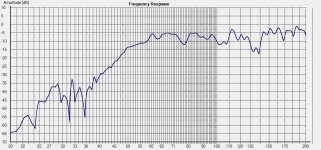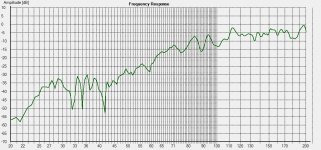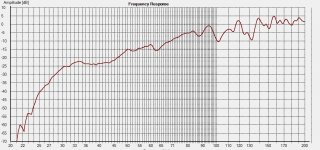Hello, here are some unfinished and preliminary thoughts/questions
on the excitation of room modes using large area planars ...
Contrary to (small area membrane) monopoles, a dipole will excite
room modes most effectively when placed in a velocity maximum of
the standing wave, given the main axis of radiation points
in the same direction as the velocity of the wave.
Let us assume both systems to be compared
- monopole, small area, higher mass/area, placement in pressure maximum of standing wave
- dipole, large area, small mass/area, placement in velocity maximum of standing wave
have some damping, which means there is a resistive force proportional to
(mean over area) membrane velocity.
Let us exite a room mode with both systems systems for comparison and please correct
my thoughts ...
The planar dipole will move in phase with the (steady state conditions)
velocity of molecules in the standing wave ?
Its (mean over area) membrane velocity will be increased by that
condition of operating in a standing wave ?
The increase in membrane velocity, compared to free space conditions,
will cause the room mode to experience some amount of damping, since
the speaker works like an absorber, although being the exiter of the mode
at the same time ?
---
The monopole described above will experience less impact in
cone movement from the pressure oscillation caused by the standing wave ?
If experiencing any significant effect, cone velocity will be reduced ?
Which means there is (if any) the opposite effect from room resonances
on cone velocity ?
---
The difference is also due to "pressure driving" vs. "velocity driving" the room ?
---
Now the main Question (to me):
Given the above assumptions are valid, would we expect a velocity source with
large area and low mass per area and sufficient damping to have a compensating
(smoothing) effect on excitation of room modes inherently with the speaker ?
As the large area diaphragm placed in a velocity maximum having mechanical
and EMK dampening components acts like a velocity absorber while being the
"exciter" at same time ?
More "control" over the room using large area / low mass per area dipole
speakers ? (Meant independently from different modal pattern being excited
due to monopole/dipole acoustical differences.)
Please correct my assumptions if those seem odd to you ...
edit: Above thoughts are resticted to the modal frequency range of the room
and to standing waves having at least a significant velocity component acting
orthogonally to the plane of the membrane ...
Kind Regards
on the excitation of room modes using large area planars ...
Contrary to (small area membrane) monopoles, a dipole will excite
room modes most effectively when placed in a velocity maximum of
the standing wave, given the main axis of radiation points
in the same direction as the velocity of the wave.
Let us assume both systems to be compared
- monopole, small area, higher mass/area, placement in pressure maximum of standing wave
- dipole, large area, small mass/area, placement in velocity maximum of standing wave
have some damping, which means there is a resistive force proportional to
(mean over area) membrane velocity.
Let us exite a room mode with both systems systems for comparison and please correct
my thoughts ...
The planar dipole will move in phase with the (steady state conditions)
velocity of molecules in the standing wave ?
Its (mean over area) membrane velocity will be increased by that
condition of operating in a standing wave ?
The increase in membrane velocity, compared to free space conditions,
will cause the room mode to experience some amount of damping, since
the speaker works like an absorber, although being the exiter of the mode
at the same time ?
---
The monopole described above will experience less impact in
cone movement from the pressure oscillation caused by the standing wave ?
If experiencing any significant effect, cone velocity will be reduced ?
Which means there is (if any) the opposite effect from room resonances
on cone velocity ?
---
The difference is also due to "pressure driving" vs. "velocity driving" the room ?
---
Now the main Question (to me):
Given the above assumptions are valid, would we expect a velocity source with
large area and low mass per area and sufficient damping to have a compensating
(smoothing) effect on excitation of room modes inherently with the speaker ?
As the large area diaphragm placed in a velocity maximum having mechanical
and EMK dampening components acts like a velocity absorber while being the
"exciter" at same time ?
More "control" over the room using large area / low mass per area dipole
speakers ? (Meant independently from different modal pattern being excited
due to monopole/dipole acoustical differences.)
Please correct my assumptions if those seem odd to you ...
edit: Above thoughts are resticted to the modal frequency range of the room
and to standing waves having at least a significant velocity component acting
orthogonally to the plane of the membrane ...
Kind Regards
Last edited:
please exchange above "EMK" by "Back EMF
(or any equivalent in case of an ESL)" ... error
was made due to german mothertongue.
Next questions:
If we had given a certain cross sectional area of resistive
(porous) material to dampen a room mode, could there be
a better place and orientation than the very cross section
where the room is (velocity) excited ?
Would we estimate turning the "excitation point" or
"area of excitation" in the listening room into a
fairly resistive load as an advantage concerning
balanced excitation of room modes ?
Kind Regards
(or any equivalent in case of an ESL)" ... error
was made due to german mothertongue.
Next questions:
If we had given a certain cross sectional area of resistive
(porous) material to dampen a room mode, could there be
a better place and orientation than the very cross section
where the room is (velocity) excited ?
Would we estimate turning the "excitation point" or
"area of excitation" in the listening room into a
fairly resistive load as an advantage concerning
balanced excitation of room modes ?
Kind Regards
Last edited:
Where are my LF room modes ?
Blue.....BR bookshelf speaker
Green...dipole line array, 6 small pistonic drivers
Red......panel form dipole
Blue.....BR bookshelf speaker
Green...dipole line array, 6 small pistonic drivers
Red......panel form dipole
Attachments
- Status
- This old topic is closed. If you want to reopen this topic, contact a moderator using the "Report Post" button.


